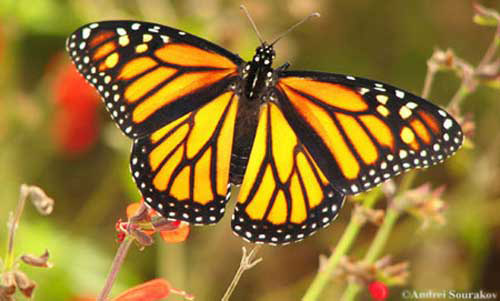
by Sheila Dunning | Oct 10, 2019
 Over 1.8 million Monarch butterflies have been tagged and tracked over the past 27 years. This October these iconic beauties will flutter through the Florida Panhandle on their way to the Oyamel fir forests on 12 mountaintops in central Mexico. Monarch Watch volunteers and citizen scientists will be waiting to record, tag and release the butterflies in hopes of learning more about their migration and what the 2019 population count will be.
Over 1.8 million Monarch butterflies have been tagged and tracked over the past 27 years. This October these iconic beauties will flutter through the Florida Panhandle on their way to the Oyamel fir forests on 12 mountaintops in central Mexico. Monarch Watch volunteers and citizen scientists will be waiting to record, tag and release the butterflies in hopes of learning more about their migration and what the 2019 population count will be.
This spring, scientists from World Wildlife Fund Mexico estimated the population size of the overwintering Monarchs to be 6.05 hectacres of trees covered in orange. As the weather warmed, the butterflies headed north towards Canada (about three weeks early). It’s an impressive 2,000 mile adventure for an animal weighing less than 1 gram. Those butterflies west of the Rocky Mountains headed up California; while the eastern insects traveled over the “corn belt” and into New England. When August brought cooler days, all the Monarchs headed back south.
What the 2018 Monarch Watch data revealed was alarming. The returning eastern Monarch butterfly population had increased by 144 percent, the highest count since 2006. But, the count still represented a decline of 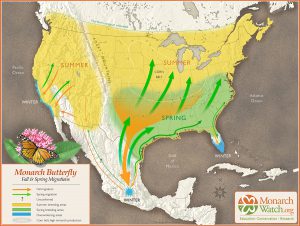 90% from historic levels of the 1990’s. Additionally, the western population plummeted to a record low of 30,000, down from 1.2 million two decades ago. With estimated populations around 42 million, the U.S. Fish and Wildlife Service began the process of deciding whether to list the Monarch butterfly as endangered or threatened in 2014. With the additional information, FWS set a deadline of June 2019 to decide whether to pursue the listing.
90% from historic levels of the 1990’s. Additionally, the western population plummeted to a record low of 30,000, down from 1.2 million two decades ago. With estimated populations around 42 million, the U.S. Fish and Wildlife Service began the process of deciding whether to list the Monarch butterfly as endangered or threatened in 2014. With the additional information, FWS set a deadline of June 2019 to decide whether to pursue the listing.
Scientists estimate that 6 hectacres is the threshold to be out of the immediate danger of migratory collapse. To put things in scale: A single winter storm in January 2002 killed an estimated 500 million Monarchs in their Mexico home. However, with recent changes on the status of the Endangered Species Act, the U.S. Fish and Wildlife Service has delayed its decision until December 2020. One more year of data may be helpful to monarch conservation efforts.
 Individuals can help with the monitoring and restoring the Monarch butterflies habitat. There are two scheduled tagging events in Panhandle, possibly more. St. Mark’s National Wildlife Refuge is holding their Butterfly Festival on Saturday, October 26 from 10a.m. to 4 p.m. Henderson Beach State Park in Destin will have 200 butterflies to tag and release on Saturday, November from 9 – 11 a.m. Ask around in the local area. There may be more opportunities.
Individuals can help with the monitoring and restoring the Monarch butterflies habitat. There are two scheduled tagging events in Panhandle, possibly more. St. Mark’s National Wildlife Refuge is holding their Butterfly Festival on Saturday, October 26 from 10a.m. to 4 p.m. Henderson Beach State Park in Destin will have 200 butterflies to tag and release on Saturday, November from 9 – 11 a.m. Ask around in the local area. There may be more opportunities.
There is something more you can do to increase the success of the butterflies along their migratory path – plant more Milkweed (Asclepias spp.). It’s the only plant the Monarch caterpillar will eat. When they leave their hibernation in Mexico around February or March, the adults must find Milkweed all along the path to Canada in order to lay their eggs. Butterflies only live two to six weeks. They must mate and lay eggs along the way in order for the population to continue its flight. Each generation must have Milkweed about every 700 miles. Check with the local nurseries for plants. Though orange is the most common native species, Milkweed comes in many colors and leaf shapes.

by hollyober | Oct 10, 2019
Insect pests can destroy substantial quantities of crops, prompting growers to invest heavily in pesticide use. Previ

These three common species of bats in FL, GA, and AL eat insect pests notorious for causing substantial damage to crops: the Seminole bat (Lasiurus seminolus), southeastern bat (Myotis austroriparius), and evening bat (Nycticeius humeralis) (photo credits @MerlinTuttle.org).
ous research in Texas suggested that bats could reduce pesticide costs by over a million dollars within their state, due to the bats’ fondness for pests that damage cotton. Scientists at UF/IFAS recently collected evidence locally that indicates bats are providing valuable assistance with pest reduction for many of the crops grown here too.
During spring and summer of 2018 scientists at UF clarified what the common species of bats were eating in north Florida, south Georgia, and south Alabama. We investigated 161 bats across 21 counties and found that 28% of these bats ate at least one Lepidopteran (moth) pest species, 21% ate a Coleopteran (beetle) pest, and 18% ate a Hemipteran (true bug) pest. In total, 12 different species of agricultural pest species were eaten by these bats.
The moth pests consumed by bats were:
- Green Cutworm Moth (Anicla infecta)
- Tobacco Budworm (Chloridea virescens)
- Soybean Looper (Chrysodeixis includens)
- Garden Tortrix (Clepsis peritana)
- Lesser Cornstalk Borer (Elasmopalpus lignosellus)
- Corn Earworm (Helicoverpa zea)
- Beet Armyworm (Spodoptera exigua)
- Fall Armyworm (Spodoptera frugiperda)
- Red-Necked Peanutworm Moth (Stegasta bosqueella)
The beetle and true bug pests consumed by bats were:
- Hairy Fungus Beetle (Typhaea stercorea)
- Tarnished Plant Bug (Lygus lineolaris)
- Two-lined Spittlebug (Prosapia bicincta)
Three of these pests (Soybean Looper, Beet Armyworm, and Two-lined Spittlebug) were most often consumed by pregnant and juvenile bats. This is good news for growers of crops affected by these pests because you have a sound option for increasing the likelihood of bats helping control them. The trick is to provide the conditions that adult female bats like near the crops these pests feed on (e.g., soybeans, peanut, cotton, corn, sorghum, safflower). Most female bats pick a maternity roost in early spring. A maternity roost is a structure that provides warm, dry, dark conditions for female bats to sleep in during the day, and it is ultimately where they give birth to pups. When selecting a site to set up a maternity roost, female bats look for structures that are large enough to provide shelter for a large number of bats. A roomy structure can accommodate many bats, which allows the flightless pups to keep each other warm while the mothers fly in search of food at night. Installing a bat house like those shown here can provide conditions appropriate for a maternity colony, increasing your chances of having bats help control these insect pests.
Another useful strategy for enhancing pest control services by bats involves creating or maintaining structures that could serve as natural roost sites for bats. The natural structures bats prefer include large trees with cavities, dead and dying trees with peeling bark, oak trees with Spanish moss, and palm trees allowed to maintain their dead fronds. In agricultural areas and suburban areas these types of trees are often in short supply.
Maintaining large, old trees of a mix of species, and supplementing with bat houses, can help ensure there are plenty of roosting options for bats. This, in turn, will increase the likelihood that bats are available to assist with your pest management.
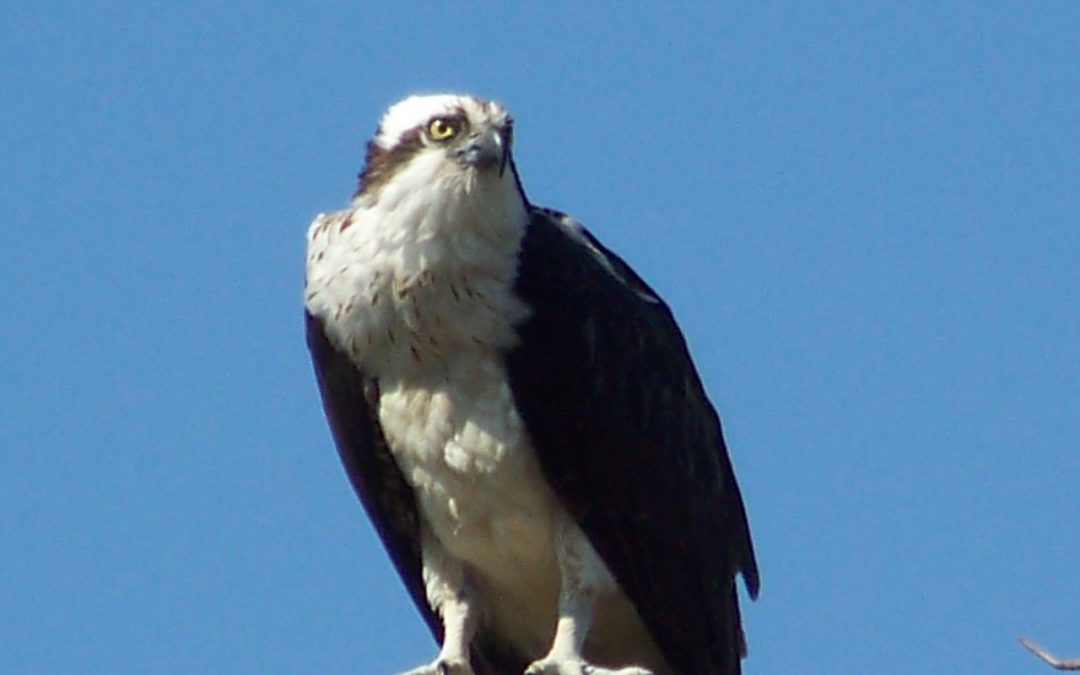
by Carrie Stevenson | Sep 27, 2019

Ospreys, or fish hawks, build their nests from sticks atop dead trees. Photo credit: UF IFAS Extension
Big hurricanes like Dorian (Bahamas) and 2018’s Michael (central Florida Panhandle) were devastating to the communities they landed in. Flooding, wind, rain, loss of power and communications eventually made way for ad hoc clearing and cleanup, temporary shelters, and a slow walk to recovery. Among the most striking visual impacts of a hurricane are the tree losses, as there are unnatural openings in the canopy and light suddenly shines on areas that had been shaded for years. In northwest Florida, pines are particularly vulnerable. After any hurricane in the Panhandle, you can drive down Interstate 10 for miles and see endless pines blown to the ground or broken off at the top. During Hurricane Ivan 15 years ago, the coastal areas in Escambia and Santa Rosa lost thousands of trees not only due to wind, but also to tree roots inundated by saltwater for long periods.
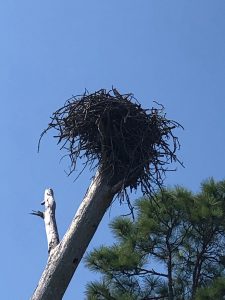
Dead trees left by hurricanes serve as ideal nesting ground for large birds like ospreys. Photo credit: Carrie Stevenson, UF IFAS Extension
Nature always finds a way, though. Because of all those dead (but still-standing) pines, our osprey (Pandion haliaetus) population is in great shape in the Pensacola area. How are these two things related? Well, ospreys build large stick nests in the tall branches/crooks of dead trees, known as snags. They particularly prefer those near the water bodies where they fish. When I first moved here 20 years ago, I rarely saw ospreys. Now, it’s uncommon not to see them near the bayous and bays, or to hear their high-pitched calls as they swoop and dive for fish.
If you are not familiar with ospreys, they can be distinguished by their call and their size (up to six foot wingspan). It is common to see them in their large nests atop those snags, flying, or diving for fish. I usually see them with mullet in their talons, although they also prey on catfish, spotted trout, and other smaller species. They have white underbellies, brown backs, and are smaller than eagles but larger than your average hawk. One of their more interesting physical adaptations (and identifying characteristics) is their ability to grip fish parallel to their bodies, making it more aerodynamic than the perpendicular method most birds use.
Ospreys mate for life, and cooperate to build nests and care for young. The species has overcome many complex threats—including DDT damage to eggs and habitat loss—but the sight of them flying is always inspiring to me. They are a living embodiment of resilience amidst adversity.
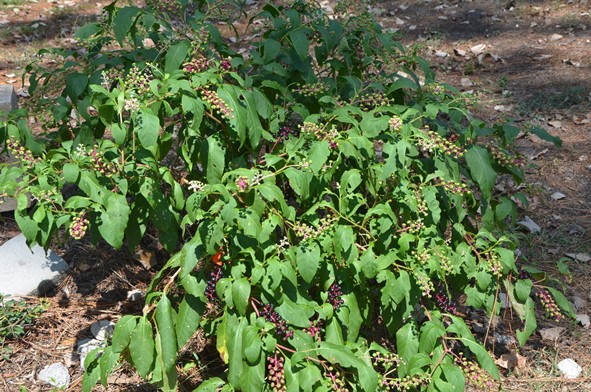
by Les Harrison | Sep 27, 2019

Pokeweed is currently producing many purple berries containing seed ready for avian distribution.
Half a century ago the AM airwaves included a tune by a rock singer who crooned about Polk Salad Annie. While not exactly epic lyrics, it did have a catchy beat which made it to number eight on Billboard’s Hot 100.
The basis of this dish was common pokeweed (Phytolacca americana), a native of North American perennial weed frequently found in pastures as well as fence-rows, fields, wooded areas and neglected residential landscapes.
The reason this plant is only on the menu of the economically distress is all parts of it contain saponins, oxalates, and the alkaloid toxin phytolacine. The roots and seeds of this species contain the highest concentrations of these compounds.
As winter moves to spring, this plant is emerging from its winter dormancy. The warm summer of 2019 has accelerated the regrowth in north Florida and the surrounding states.
Once pokeweed becomes established, it regrows each year from a large, fleshy taproot which penetrates over a foot deep. The crown of the root is where the plant is regenerated and can be as large as five and a half inches in diameter at the soil surface within two growing seasons.
Pokeweed usually has a red trunk like stem, which becomes hollow as the plant matures later in the year. Leaves become quite large as the plant grows to its full potential and are the basis for the Polk salad.
The process for rendering the leave edible by humans, or other mammals, involves boiling and washing with a second boiling and more washing. Short of eminent starvation, it is not a good or safe meal choice for dining.
When in bloom the individual flowers appear green to white and are typically missing petals. Fruits are green when immature and turn a deep purple to black at maturity which is the basis for one alternate name for this species, inkberry.
Each fruit contains about nine small, hard-shelled seeds. Pokeweed can produce a few thousand seeds to over 48,000 seeds per plant annually.
In the right situation these seeds may remain viable in the soil for over four decades (40 years). When exposed to favorable environmental conditions the seed sprout and the process is repeated.
While not a suitable selection for people or livestock, birds eat the fruits without much evidence of harm and are usually the means for seed dispersal. Roosting sites along fence rows and under utility lines frequently show signs of seed deposits.
In addition to feeding cardinals, mocking birds, cedar waxwings and other avian species, the pokeweed is host to a variety of insects. Some are beneficial and others are not.
A number of caterpillars utilize this weed to sustain their larval stage of development. Unfortunately, some other less desirable insects use the local weed, too.
Pokeweed can act as reservoirs of various viruses transmitted by insects which are destructive to vegetable and ornamental plants. Whiteflies and aphids are the main culprits, but other insect species can contribute the disease issue.
Old rock tunes aside, it is best to leave the pokeweed and Polk salad to the bugs and birds.
To learn more about pokeweed read the UF/IFAS publication COMMON POKEWEED.

by Carrie Stevenson | Aug 16, 2019
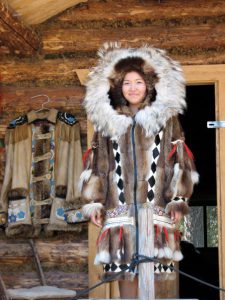
The indigenous people of Alaska have long adapted to freezing winters by relying on local wildlife for warm clothing. Photo credit: Carrie Stevenson, UF IFAS Extension
Human beings are an incredibly adaptable species. For countless generations, our ancestors have migrated to the far reaches of the planet to find food and territory. The Inuit people of Alaska adapted to months of freezing weather and darkness by developing techniques for harvesting fish through the ice and making furs from local wildlife. Meanwhile in the remote Andaman Islands, tribal people still subsist on fruit from the prolific rain forest and spearfishing in the Bay of Bengal.
Wildlife have behaved similarly throughout history. Before much of the United States was developed and crisscrossed with roads, large herds of bison grazed the entire mid and mountain west. Until the mid 1960’s, the upper Midwest and east coast experienced a tree-based squirrel migration of millions. Overhunting also impacted both of these species. According to the National Wildlife Foundation, monarch butterflies migrating for the winter from the United States to Mexico were down 15% last year due to hurricanes, warmer fall temperatures, and a lack of food sources along their routes. Overall, monarch numbers are down 90% from a peak population 20 years ago.

Worldwide, mangrove trees are moving from warmer climates into temperate habitats as climate changes. Photo credit: Carrie Stevenson, UF IFAS Extension
Recent changes in climate are also becoming a factor for human and wildlife behavior. I find myself “migrating” into the air conditioning more often in these dog days of August as 110°+ heat indices bear down. The European heat wave this summer resulted in record-breaking temperatures and at least 8 deaths. Many European countries have never needed air conditioning, so homes, public transportation, and vehicles provide no relief from the sweltering heat. Wildlife, by contrast, cannot move indoors. As the planet warms, some wildlife living in temperate regions may move because their homelands slowly turn subtropical. When this happens, history shows us that humans either “persecute, protect, or ignore” new species, which may result in great success or the downfall of species seeking new habitat. In addition, biologists have been observing and expecting many tropical species of plants and animals to expand into new, warmer territories, as formerly cold climates heat up and become more suitable for particular species to thrive. Mangroves, for example, are migrating beyond the equator worldwide, while the National Oceanic and Atmospheric Administration (NOAA) Arctic report card has shown that the melting of polar ice caps has literally broken up polar bear habitat, along with reducing populations of grazing herds of caribou and reindeer.
Keep in mind that neither one hot summer nor one cold winter define the pace of climate change. The issue at hand is the long-term change. We find ourselves, in August 2019, having just experienced the hottest July (globally) on record since worldwide recordkeeping began in 1880. Some may see this as a fluke, until we consider that NOAA and NASA data show that 17 of the 18 warmest years have occurred since 2001. The patterns are changing—and as always, we humans must adapt. It is important that our adaptation includes mitigation measures, which can range from reducing energy use to planting more trees. To learn more about changes in worldwide climate and what you can do to make a difference, visit the NOAA site https://www.climate.gov/
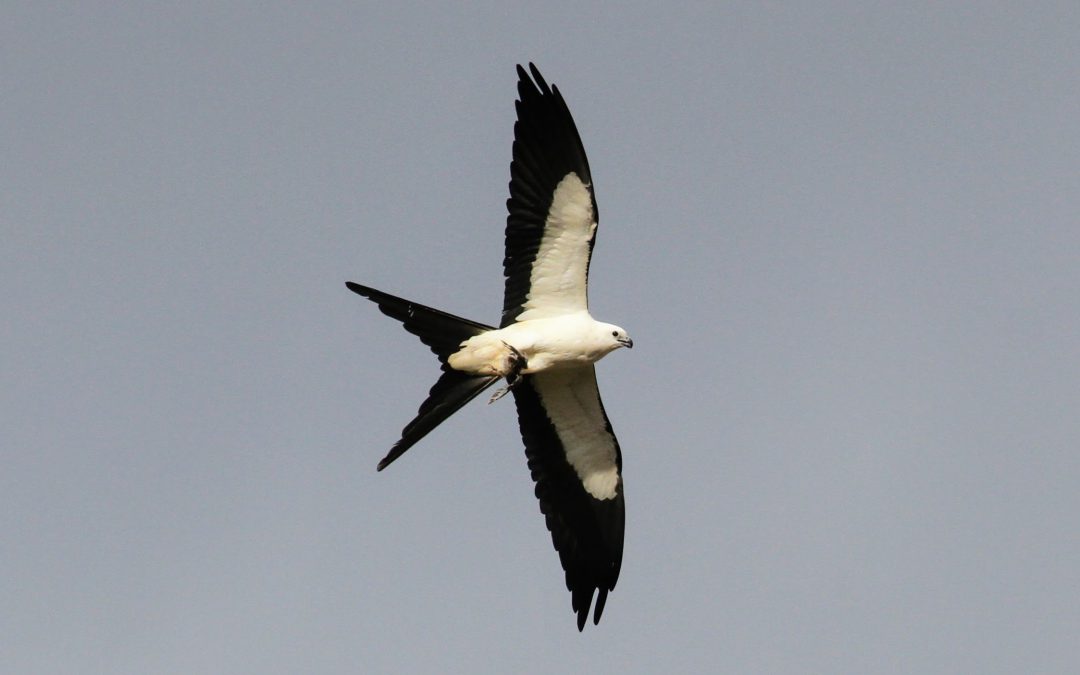
by Erik Lovestrand | Jun 21, 2019

Mississippi kites are smaller but impressive aerialists as well. Photo by Andy Reago, Flickr Creative Commons.
Dime store kites were never very expensive, but it still seemed like a luxury when I was growing up and it was a rare thing for us kids to see a store-bought kite flying over our neighborhood. An old paper grocery bag (remember those), some cotton string for the corner loops, and two dog fennel sticks cut from the back field provided the basic ingredients for us to make our own. With a little creative cutting and gluing, and the attachment of a tail made from torn strips from a worn-out shirt, it was a thing of grace and beauty and was soon aloft on the wind. On a good day, with the right breeze (not too light, not too gusty), we could run out two full rolls of kite string until the kite was just a speck in the distance. The real challenge was winding all of that string back in after the kite came down across houses, powerlines and fields.
Please forgive the digression but thinking about the topic for this article sent me on a little trip down memory lane. We are fortunate to have two very interesting avian species of kites that grace our summer skies over North Florida. Both are exceptional aerialists but one of them in particular will leave a visual image that is hard to shake. The swallow-tailed kite (Elanoides forficatus) is one of the most impressive birds on the planet with its stark white belly and under-wing coverts, outlined in bold black trim. Its deeply forked tail gives rise to several descriptive names such as split-tailed hawk and fork-tailed hawk, among others. Each spring, swallow-tailed kites migrate in small groups back to their breeding range that extends into the Florida Peninsula and sections of the Panhandle, including several North Florida counties. I’ve seen up to 21 kites flying over the Apalachicola River floodplain during this time of year. Forested swamp habitats along river corridors are particularly valuable for foraging and nesting areas but these graceful flyers are also observed over agricultural fields and pastures where they catch dragonflies and other bugs on the wing; usually dining in the air. Nesting takes place in treetops and young are fed a mixed bag of insects, tree frogs, lizards and small snakes, most snatched from the treetops in flight. Occasionally, the young of other birds are taken from their nests and added to the menu. After the young have fledged from the nest, it isn’t long before our kites head back to their wintering grounds in South America. Young birds can be identified by their less-deeply forked tail, due to the short outer tail feathers.
The other kite that graces our area during summertime is the Mississippi kite (Ictinia mississippiensis); not quite as flashy as its fork-tailed cousin but beautiful in its own right. Adult Mississippi kites are a pearly gray color with darker wings and tail. They are significantly smaller, with a wingspan of about 3 feet (swallow-tailed kites have a wingspan up to 4.5 feet). Wintering grounds are in South America also but the breeding range in the US includes several western states such as Texas, Oklahoma and even sparsely in New Mexico and Arizona. This species is known to vigorously defend its nest by dive-bombing trespassers who get too close.
I see both species flying around my house in Wakulla County and without fail, I pause to appreciate the grace, beauty and tremendous distances covered during annual flights by these long-distance migrants. Keep looking up during our summer months and you may well be rewarded by a glimpse of these two “kites over North Florida.”

 Over 1.8 million Monarch butterflies have been tagged and tracked over the past 27 years. This October these iconic beauties will flutter through the Florida Panhandle on their way to the Oyamel fir forests on 12 mountaintops in central Mexico. Monarch Watch volunteers and citizen scientists will be waiting to record, tag and release the butterflies in hopes of learning more about their migration and what the 2019 population count will be.
Over 1.8 million Monarch butterflies have been tagged and tracked over the past 27 years. This October these iconic beauties will flutter through the Florida Panhandle on their way to the Oyamel fir forests on 12 mountaintops in central Mexico. Monarch Watch volunteers and citizen scientists will be waiting to record, tag and release the butterflies in hopes of learning more about their migration and what the 2019 population count will be. 90% from historic levels of the 1990’s. Additionally, the western population plummeted to a record low of 30,000, down from 1.2 million two decades ago. With estimated populations around 42 million, the U.S. Fish and Wildlife Service began the process of deciding whether to list the Monarch butterfly as endangered or threatened in 2014. With the additional information, FWS set a deadline of June 2019 to decide whether to pursue the listing.
90% from historic levels of the 1990’s. Additionally, the western population plummeted to a record low of 30,000, down from 1.2 million two decades ago. With estimated populations around 42 million, the U.S. Fish and Wildlife Service began the process of deciding whether to list the Monarch butterfly as endangered or threatened in 2014. With the additional information, FWS set a deadline of June 2019 to decide whether to pursue the listing. Individuals can help with the monitoring and restoring the Monarch butterflies habitat. There are two scheduled tagging events in Panhandle, possibly more. St. Mark’s National Wildlife Refuge is holding their Butterfly Festival on Saturday, October 26 from 10a.m. to 4 p.m. Henderson Beach State Park in Destin will have 200 butterflies to tag and release on Saturday, November from 9 – 11 a.m. Ask around in the local area. There may be more opportunities.
Individuals can help with the monitoring and restoring the Monarch butterflies habitat. There are two scheduled tagging events in Panhandle, possibly more. St. Mark’s National Wildlife Refuge is holding their Butterfly Festival on Saturday, October 26 from 10a.m. to 4 p.m. Henderson Beach State Park in Destin will have 200 butterflies to tag and release on Saturday, November from 9 – 11 a.m. Ask around in the local area. There may be more opportunities.











